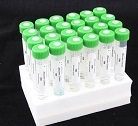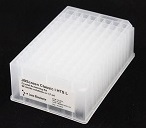JBScreen Pentaerythritol
JBScreen Pentaerythritol has been designed for efficient crystallization screening of biological macromolecules based on pentaerythritol polymers as precipitants. The screen was developed by Ulrike Demmer from the Max-Planck-Institute for Biophysics in Frankfurt.
Product Information
JBScreen Pentaerythritol has been designed for efficient crystallization screening of biological macromolecules based on pentaerythritol polymers as precipitants. The screen was developed by Ulrike Demmer from the Max-Planck-Institute for Biophysics in Frankfurt.
The choice of a suitable precipitant is of crucial importance for the crystallization of proteins. JBScreen Pentaerythritol utilizes two novel precipitating agents, i.e. pentaerythritol propoxylate and pentaerythritol ethoxylate. Both are branched polymers containing a pentaerythritol backbone. Thus they differ from more traditional precipitants like MPD and PEG’s in size and nature.
In addition, pentaerythritol polymers function as cryoprotectants. Protein crystals grown in high concentrations of these precipitants can be frozen directly from the crystallization drop. The successful application of pentaerythritol polymers to yield protein crystals was first described by Gulick et al. [1]. Furthermore, this class of precipitants has been used for membrane crystallization: The X-ray structure of cbb3 Cytochrome Oxidase was published in Science in 2010. Crystals of this proton pumping membrane protein were successfully grown using pentaerythritol ethoxylate as precipitation agent [2].
JBScreen Pentaerythritol comprises of 96 unique conditions, based on 4 different pentaerythritol polymers as precipitating agent:
Pentaerythritol propoxylate 426 (5/4 PO/OH)
Pentaerythritol propoxylate 629 (17/8 PO/OH)
Pentaerythritol ethoxylate 270 (3/4 EO/OH)
Pentaerythritol ethoxylate 797 (15/4 EO/OH)
The 4 polymers are arranged to a grid screen, thus allowing screening i) of three different precipitant concentrations, ii) four different pH values and iii) with and without the addition of salts, i.e. magnesium chloride, ammonium sulfate, potassium chloride.
The advantage of JBScreen Pentaerythritol not only lies in the novel 96 conditions but also in the systematic arrangement of the unique reagents, which enables the user to compare individual conditions directly. Even if initial screening may not always yield crystals, valuable information about the protein under investigation can be obtained from the scoring sheet.
Format
Bulk – 24 or 96 screening solutions in 10 ml aliquots
HTS – 96 screening solutions delivered in a deep-well block, 1.7 ml per well
References
[1] Gulick et al. (2002) Pentaerythritol propoxylate: a new crystallization agent and cryoprotectant induces crystal growth of 2-methylcitrate dehydratase. Acta Cryst. D58:306.
[2] Buschmann et al. (2010) The Structure of cbb3 Cytochrome Oxidase Provides Insights into Proton Pumping. Science 329:327.
Selected Literature Citations of JBScreen Pentaerythritol
Weidenweber et al. (2017) Structure of the acetophenone carboxylase core complex: prototype of a new class of ATP-dependent carboxylases/hydrolases. Sci. Rep. 7:39674.
Fujita et al. (2017) Identification of the key interactions in structural transition pathway of FtsZ from Staphylococcus aureus. J. Struct. Biol. DOI 10.1016/j.jsb.2017.04.008.
Wagner et al. (2016) The methanogenic CO2 reducing-and-fixing enzyme is bifunctional and contains 46 [4Fe-4S] clusters. Science 354:114.
Demmer et al. (2015) Insights into Flavin-based Electron Bifurcation via the NADH-dependent Reduced Ferredoxin:NADP Oxidoreductase Structure. JBC 290:21985.
Rekittke et al. (2015) Structure of the GcpE-HMBPP complex from Thermus thermophilius. Biochem. Biophys. Res. Commun. 458:246.
Uchida et al. (2014) Structure and properties of the C-terminal β-helical domain of VgrG protein from Escherichia coli O157. J. Biochem. 155(3):173.


